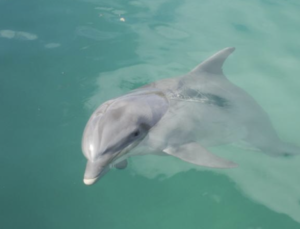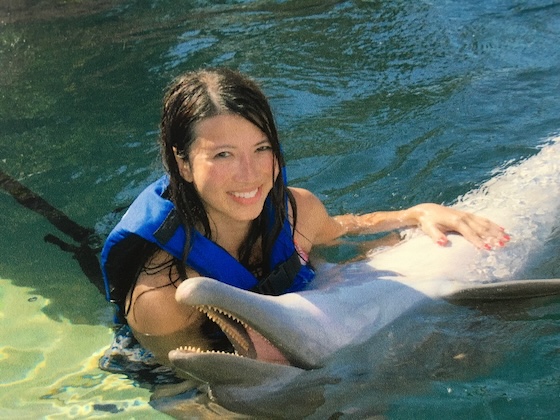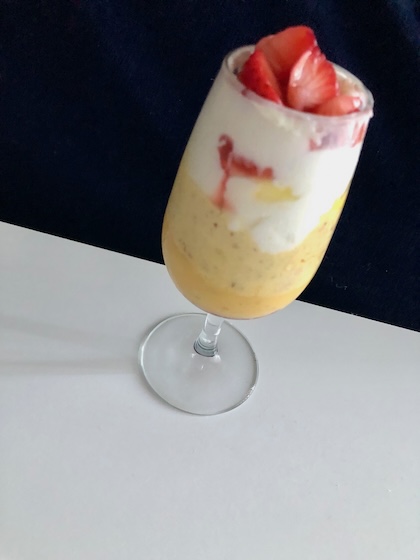Dolphin pose yoga is a common pose like Downward Dog. Both animals are enticing to pet and add joy to our celebration of life.

But if you can’t get your hands on petting a dolphin, today is National Strawberry Parfait Day.
You can celebrate a simple moment of joy with a summertime strawberry lemon parfait you can make that’s healthy and 100% delicious!
…You can also get in your Dolphin pose right where you are! 🐬
For inspiration, dolphins are one of the friendliest animals to us out there… and we think of them as our happy, summer ocean friends we can pet.
…Next to our dog land friends. And maybe that’s why the yoga Dolphin pose is similar to Downward Dog… and both poses are done on dry land.
In Dolphin pose yoga moves, instead of your arms fully stretched out, your elbows bend while your forearms and palms are laying flat like pancakes on the mat.
Because of this, your nose in awareness is also a lot closer to the mat.
…Like dolphin beaks called rostroms that are in placement where noses usually are on mammals.
This gives dolphins their appearance that they’re smiling and then when they show their pearly whites, we smile… and maybe that’s partially how they charmed their way to Hollywood as celebrities in Dolphin Tale with Florida home perks. 😉
But back to noses, dolphins have blow holes at the top of their heads where air is connected to their lungs.
This is where they breathe like us (and not like fish with gills)… and we can remember them in our daily Ayurvedic yoga breathing.
On the mat (…maybe you’re there now?), our Dolphin pose yoga fins and palms are also flat on the mat for good yoga form.
You get a good stretch in your entire body from head-to-toe in Dolphin pose yoga moves.
What you may notice that’s different is your body formation.
Your top half of your body may not be the same length as your bottom half.
If you have long legs and a shorter torso, then you won’t be as high peaked.
Your upside down “V” in the air will look different if that’s your body description. So you get to play around (or splash around 💦) in your Dolphin pose.
…You’ll be more like a hill than a mountain by design.
And that helps you to embrace your unique body and special creature that you are!
…You look more like a dolphin swimming instead of jumping hoops in dolphin show formation. 😁
Like us, dolphins are social and intelligent creatures with abilities.
To get more of their vibe, you can swim with a dolphin and not be afraid that you’ll be thrown.
Well, I take that back…

That was a dolphin ride! Even though in the beginning I wasn’t sure what to expect 🤔
But I did know dolphins are happy and friendly creatures, so I knew we’d get along great in the end. And we did that day.
So all was good…
And I got my Vata anti-worry and cool and simple Pitta balancing self-therapy day in.
In that spirit, you can try these other water animal yoga poses that help with flexibility, and you can do on dry land without a splash.
Water Animal Poses
You can use Dolphin pose as a transition break pose before ending in Fish Pose (that’s an opposite position pose on your back), reminding us that dolphins aren’t fish.
And if you’re starting in Dolphin, you can then transition into a Turtle Pose, turning and facing sideways on the mat.
This way you can use the length of the mat and get a new perspective of your surroundings.
💡This is a good metaphor in life to change your perspectives for good outcomes.
Turtle Pose is especially good for shoulder streching and tight hamstrings where you’ll feel a good stretch in those parts.
In the pose, your shoulders are a bit hunched over forward to give that turtle back look. 🐢
Turtle is a low to the ground pose where you’re seated and legs are ideally in “V” formation laying flat on the mat, or with slightly bent knees until you get more flexible.
Yoga is a journey.
Then you span your wings (that were fins in Dolphin pose) as far from one end to the other underneath your legs.
Maybe you bend forward with body closer to the mat if you can.
You can challenge yourself daily to bend forward as much as you can in the pose, and then build up your flexibility with knees straightening and legs flattening down toward the mat.
Then after you’ve spent enough time as a turtle, you can turn into a frog.
…Which btw, turtles are reptiles and frogs are amphibians even though they both live on land and water.
And in your land-water abilities, still optimizing the length of the mat, you can flow your legs that were positioned forward in a “V” previously… and move them behind you like frog legs.
Your arms can rest on the mat and floor in front of you.
Frog Pose is exceptional for inner hip and thigh flexibility.
🎉Between turtle and frog, you’re getting full upper leg stretches. Your legs are in the largest muscle group in the body.
You optimize your legs in Frog pose that looks just like the yoga pose name, so it’s easy to remember and get into the position.
If you’re a swimmer and know frog swimming strokes, then you’ll be a natural. 🐸
This is a good pose to challenge yourself and see how low you can go eventually, but if you can’t get there just yet (and still feeling a bit like a turtle), blocks are good to rest your forearms on.
For any yoga pose, don’t hurt yourself by overdoing it the first go-round.
Let yourself open up slowly like a lotus 🪷 and that way you protect your joints and tissues from injury.
💡It’s better to start up high and easy and then work your challenging way down, down, and more down to the mat over time.
In a good way, yoga can take you out of your regular norm and reset your mind because usually going down references in your day are easier than getting up and going.
You can pause and think about that one in the pose. And the longer you spend in the pose, the better! 😊
If you spend 5 seconds in a pose, that counts for total time. If you spend 30 seconds in one pose, that’s 6 times the amount for total time.
Not that you’re playing a game of keeping score, but the point is the longer you spend, the greater the daily benefit… and for next time.
Yoga flexibility is all about gradually stretching further each time.
The longer you hold the pose, the more flexible you become in your body’s abilities.
So don’t expect it to happen the first time.
And if you take a break or a season off from yoga, you’ll start over in flexibility. BUT, the your body cells don’t forget so you’ll likely get there quicker than the first time you tried.
Like dolphins that have good memories, body cells also have good memory.
And like the turtle fable metaphor, slow and steady wins the race.
If you’re naturally super flexible, you can rest your forehead on the back of your hands in front of you for both poses.
Then to round out your water poses, you can finish by going into a seated position and laying back into Fish pose. You can do a Dolphin pose yoga move before your transition if you like.
Fish Pose is a great stretch for your neck.
You lay back with your elbows resting on your mat behind your shoulders like you’re catching some rays. ☀️
Then you let your neck rest backward behind you.
Your neck could be wound up as we spend most of our day with our heads and necks leaning forward especially if we work most our day on a device.
So a counteracting reverse pose like Fish Pose helps our neck unwind.
Before you try it full on without prep, it’s good to stretch your neck looking up first to get it more ready and flexible.
Our necks are delicate because they have such small muscles that also have to hold up our heads that weigh like bowling balls.
Like other areas of injury, necks can take weeks to fully heal so be gentle the first few times.
For precaution, a good pre-stretch for the stretch can be practicing looking up toward the ceiling at least 15 seconds several times a day.
I micro-habit stack this move while I’m filling up the filtered water pitcher that takes about that amount of time.
You can also do head circular motions wherever you are and turn your neck from side to side. Those are good if you spend a lot of time car seated.
Hope this keeps you encouraged in your yoga moves and instruction. Stay cool! 😎

